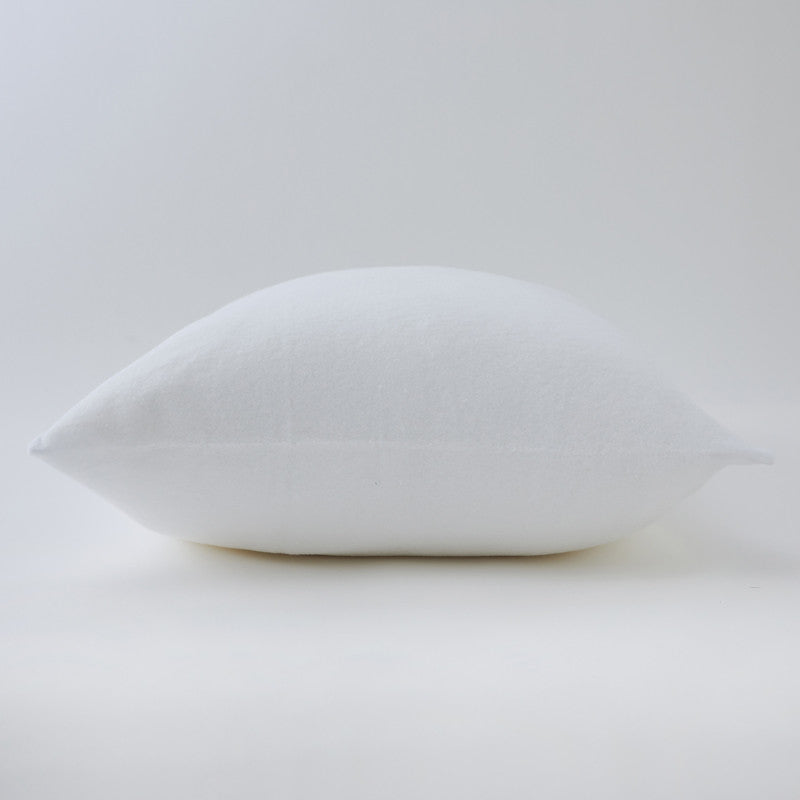The pillow protector is an often overlooked bedding accessory. Yet it plays an essential role in preserving the quality of your bedding and your well-being. Discover all the benefits of this simple yet effective protection!
What is a pillow protector?
Pillow protectors are often the unsung guardians of our sleep, but their importance should not be underestimated. These special covers are designed to completely encase your pillow, offering extra protection against various factors that can compromise its cleanliness and durability.
The difference between pillowcases and pillow protectors
These bedding accessories both have a different purpose. As such, they complement each other and should not be confused.
Pillow protectors focus on protection against allergens and liquids. They are there to protect your pillow and extend its life. They're real covers, keeping your pillows out of harm's way. They are simple because they need to be as discreet as possible.
Pillowcases add a touch of style to your bedding. Pillowcases can have ruffles, piping, embroidery, etc., and come in a variety of colors. This creates a harmonious ambience in your bedroom. They add an extra touch of comfort: you can choose the material to suit your preferences.
Together, these two elements work in tandem to offer you complete protection and optimum comfort in style!
How does the pillow protector protect your bedding?
Stain protection
The pillow protector acts as a first line of defense against unwanted stains that could compromise the cleanliness and comfort of your bedding. the aesthetics of your pillow. Whether it's a coffee stain spilled over breakfast or a beauty treatment not fully absorbed by your skin or hair, this protection is there to prevent these incidents from penetrating the fabric of your pillow and damaging it.
Protection against moisture and perspiration
Night-time perspiration is a common phenomenon that can leave your pillow damp and smelly. However, with a pillow protector in place, you can sleep in peace, knowing that your pillow is protected from excessive moisture. The pillow protector absorbs perspiration, preventing your pillow from becoming a breeding ground for bacteria and mould.
Pillow protectors insulate your pillow from moisture and perspiration. They prevent the formation of stains and unpleasant odors.
Fewer dust mites
Dust mites are small, invisible creatures that feed on skin flakes and thrive in warm, damp environments. Unfortunately, our pillows provide the ideal habitat for these unwelcome allergens. However, by using a pillow protector, you create a physical barrier that limits dust mites' access to your pillow, reducing their numbers and contributing to a healthier sleeping environment.
By protecting your pillows, you save them from premature wear and tear. They stay fresh and clean longer, so you don't have to replace them frequently.
Which material is best for effective protection?
We recommend cotton pillow protectors: percale, fleece, flannel or jersey. Cotton has the advantage of protecting your pillow, while letting it breathe.
So, if you have a silk pillow, a cotton protective cover will retain all the thermal benefits of silk.
If you need waterproof pillow protection, you may prefer our cotton jersey and polyurethane pillow cover. The polyurethane provides effective protection against liquids, making the cover perfectly waterproof.
How do I care for a pillow cover?
All our pillow protectors are machine-washable and easy to clean. How often you need to wash your pillow protectors depends on a number of factors:
- The type of pillow protector: Waterproof and anti-mite pillow protectors need to be washed more often than ordinary pillow protectors.
- Frequency of use: If you use your pillow every day, you'll need to wash it once a week.
- Perspiration: If you perspire a lot at night, we recommend washing at least once a week.
- Allergies: If you're allergic to dust mites, a weekly wash is essential.
- The type of pillowcase used: If you sleep with a silk pillowcase, your pillow protector will stay healthy longer. Silk is naturally antibacterial and anti-mite. It thus forms a first line of defence against microbes.
As a general rule, we recommend washing pillow protectors at least two to three times a year. three times a month, unless you're using a silk pillowcase. In that case, you can wash them 1 or 2 times a month at the same time as your pillowcase.
Discover our range of pillow protectors for your bedding
Much more than a bed accessory, the pillow protector takes care of your bedding. Whether it's stains, dampness, perspiration or dust mites, this protection will keep your pillow clean. Cleaner and healthier, your bedding offers you optimal sleeping space.
At Maison de la Soie, we offer covers from 8.99€. Discover now our selection to enjoy a peaceful and revitalizing rest, every night.
Sleep soundly
Soft, breathable or waterproof pillow protectors: find the model to suit your needs and extend the life of your bedding.
Browse our pillow protectors








Leave a comment